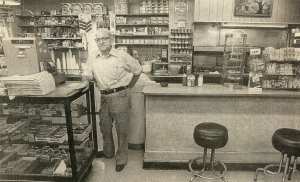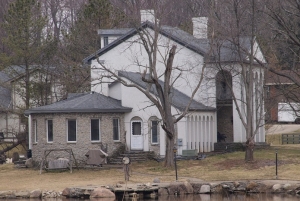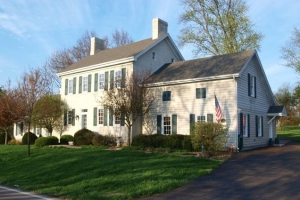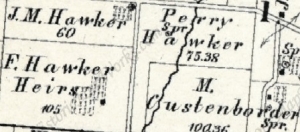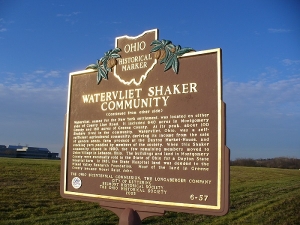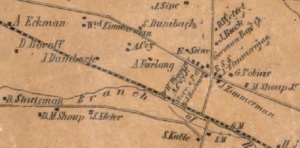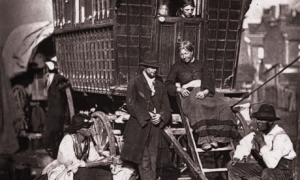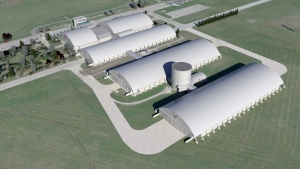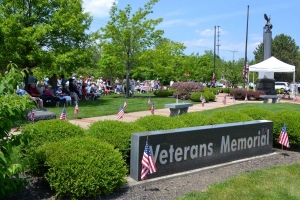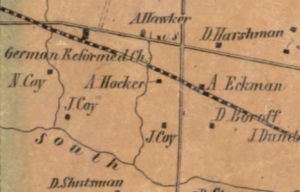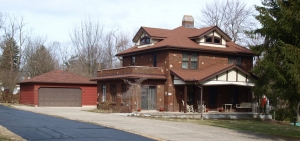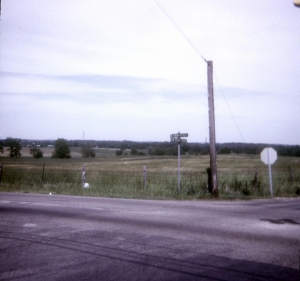Displaying items by tag: BeavercreeksFinest
We've come a long way, baby! Welcome to the latest incarnation of the site! Over the years, BeavercreeksLiving.com has evolved from a clunky news and info project into a mobile-responsive special feature site about the wonderful community we call home.
As you approach the intersection of Dayton-Xenia Road on Factory Road, an early-1900’s icon sat upon the corner on your right - the Beaver Grill. Although started years earlier, the restaurant experienced real growth after its expansion from a simple pool hall in 1928. The menu was simple. Sandwiches, soup, soft drinks, coffee and candy were available. The Beaver Grill was a popular spot for BHS students to sneak to during lunch and the gracious, but business minded owners never seemed to know the Truant Officer's telephone number.
Many stories circulate about the Beaver Grill. Once Elber Shoup, a regular, became so fed up with the burnt toast that he went behind the counter, unplugged the toaster and threw it into the middle of Factory Road. Then owner Whitey Marshall got REALLY upset and was throwing a tantrum about it. Unbeknownst to him, Elber had already purchased a brand new toaster and presented it to Whitey once his face had reached a more appropriate shade of red.
Through the tragedy of fire, the death of founder Hugh Marshall and numerous subsequent owners, the Beaver Grill survived until 1982 when the location was sold.
The building was demolished in 1986 so that the intersection could be improved. A loosely organized “Club” involving plenty of coffee and tall tales frequented the Grill, their meeting place known as the Liar’s Table as they always occupied the same spot. The table reportedly made its way to different locations after the Beaver Grill closed – and rumor has it familiar faces continue to enjoy coffee and the now-even-grander stories at various places around town!
The Liar's Table has found a new home at Irongate Realtors on Kemp Road in their 'Beaver Grill' meeting space - I hear you can request it for the closing of your real estate transactions!
 Ladies of the Beaver Grill
Ladies of the Beaver Grill
Ladies of the Beaver Grill
Ladies of the Beaver Grill
 The Beaver Grill
The Beaver Grill
The Beaver Grill
The Beaver Grill
 The Beaver Grill
The Beaver Grill
The Beaver Grill
The Beaver Grill
 Beaver Grill Yearbook Ad
Beaver Grill Yearbook Ad
Beaver Grill Yearbook Ad
Beaver Grill Yearbook Ad
 The Liar's Table
The Liar's Table
The Liar's Table
The Liar's Table
 The Beaver Grill
The Beaver Grill
The Beaver Grill
The Beaver Grill
 Marshall Brother Wrecking
Marshall Brother Wrecking
Marshall Brother Wrecking
Marshall Brother Wrecking
https://www.beavercreekliving.com/best-of-beavercreek/itemlist/tag/BeavercreeksFinest#sigProIdb24fbe8595
Continue north through the intersection. On the right are several farmhouses dating to the late 1800’s. Turn left on Tara Trail E. Beyond the third house is a clearing where you can look north and see the gorgeous Colonial at 2800 Tara Trail, built by Jacob Hanes (previously Haines) Jr. He, his wife Mary (Nesbitt) and their three children loaded into a covered wagon and immigrated to this 430-acre tract of land from West Virginia in 1805 that had been purchased by his father, John on a previous trip.
Jacob, later known as Judge Hanes, held some of the most prominent offices in the county, serving as an associate judge for seven years and a longtime Justice of the peace. He was also a veteran of the War of 1812. He and Mary had seven children including Jonathan ‘Squire’ (local distiller and farmer), Jacob (married Adam Coy’s daughter Susan and had seven children, John N. and Henry being Captains in the Union Army). The family also owned large tracts of land along Hanes Road, not-so ironically. Please return to N. Alpha-Bellbrook Road and turn left.
In the 1970's and 80's, the Parks family hosted a wide array of exotic animals on their acreage that's now part of Tara Estates. Amid the smell of Southern Comfort in the air, reports of a camel, buffalo, peacocks, llama, emu, a yak with a crush on a donkey, ostriches, possibly an ill elephant rescued from a circus and a beer guzzling bull are most prominent!
As you continue south, pass through the stop sign at Swigart Road. You’re now on land that in the early 1800’s was the 250 acre farm of Samuel Puterbaugh, you’ll find his beautiful home at 407 South Fairfield Road.
Please turn left onto Stutsman Road and left again onto South Alpha Bellbrook Road.
Up the hill and down the sweeping right curve leads you through farms owned by the Custenborder family as well as additional Hawker land including the Hawker-Graham House at 581 Grange Hall Road. John Martin Hawker, Civil War veteran and grandson of Andrew Hawker, built this home in 1894 on the limestone foundation of his father, Frederick’s home which had been destroyed by fire. John had lived in a small home at the southwest corner of Shakertown and Grange Hall Roads. The house, barn and outbuildings are part of what was a 163 acre farm that was part of the original 3,000 acres purchased in 1803 by Jacob Coy, father-in-law of Andrew Hawker. The original 1894 house interior remains, including the modest ballroom on the third floor.
A beautiful farmhouse at the southeast corner of Shakertown and Grange Hall Roads first appears on an 1896 map of Beavercreek and was likely a member of Valentine P. Coy’s family.
Formerly at the southeast corner of the intersection at Shakertown Road was the Belmont Auto Theatre. Whether with a butter-saturated paper grocery sack full of delicious, coconut oil popped popcorn or a cooler full of Little Kings, going to the Belmont Auto Theatre was always a memorable night! Often it'd be so hot you'd stick to the vinyl, rear-facing seat of the LTD wagon. Make the trip past the ticket gate in the trunk or huddled up on the floor board became a sport of its own! The Belmont Auto Theatre operated until 1997 and was demolished in 1998.
 Belmont Auto Theatre
Belmont Auto Theatre
Belmont Auto Theatre
Belmont Auto Theatre
 Early Sign On Back Of Screen
Early Sign On Back Of Screen
Early Sign On Back Of Screen
Early Sign On Back Of Screen
 Belmont Drive-In Ad
Belmont Drive-In Ad
Belmont Drive-In Ad
Belmont Drive-In Ad
 Heaters At The Theatre
Heaters At The Theatre
Heaters At The Theatre
Heaters At The Theatre
https://www.beavercreekliving.com/best-of-beavercreek/itemlist/tag/BeavercreeksFinest#sigProIdc48ab516ed
Thanks to our friends at Dayton History Books:
Belmont Auto Theatre
Maxwell A. Milbauer and his wife, Emma, enjoyed entertaining children in the Belmont area by showing 16 mm movies on a large sheet that hung in their back yard. On one particular evening Elvin Doll, and his wife Edith, came over to watch a movie. Max and Elvin, who worked together at the Hyland Machine Company, had talked a few times before about beginning a business of their own, but hadn’t really thought of any venture that suited them yet. Edith remarked that perhaps they should open an outdoor theater where people could watch a movie in the comfort of their car. The two men agreed that this was a good idea and brought in another co-worker, Joe Flory.
“But when they built the Belmont Auto they got into trouble quickly, declares Elvin and Edith Doll’s son, Alan, who was general manager of B.A.C. Theatres from 1966 to 1979. “Miller Brothers (Excavating) was out there building for them and they just practically got into a monsoon. They had a terrible time trying to build that place. They about went out of business before they even got started because the weather wasn’t on their side. The weather was really bad, they got stuck in the mud, literally, and they had to bring in another partner, which was Al Foor. And they were trying to make a go of it and they just couldn’t do it and ran out of money. They’ve got Miller out there with that big equipment. So they brought in Kenny Curp. Next thing you know they still didn’t have enough so they brought in Bill Swaney.” This was the beginning of the Belmont Amusement Company, later to be known as B.A.C. Theatres.
“We built the business on a shoestring, and did a lot of the work ourselves,” laughs Joe Flory. This included mixing the concrete for the bases of the speaker posts, as well as pouring and finishing the floor of the concession stand.
Finally, as the theater neared completion, August 6, 1947 was chosen for the grand opening date.
“We even sent out invitations,” says Flory. “Unfortunately, up came a big storm. Dayton Power and Light didn’t have the electricity hooked up yet, we were running that close to getting open. They came out and it was lightning and thundering. They didn’t want to go up the pole and I didn’t blame them so we had to cancel the opening night.”
The Belmont Auto Theater finally opened at 2060 County Line Road in Dayton, on August 7, 1947. The Belmont would become the first drive-in in the area to introduce stereophonic sound, car heaters, 3-D movies and CinemaScope, and one of the few one-screen theaters to offer two concession stands. One sat in the middle row and another was placed in the back.
In 1954 the Belmont added new sections to its original screen to make a CinemaScope screen 96’ wide and 65’ high. It was the second largest in the country at the time, surpassed only by Sherwood Twin’s new 100’ x 65’ screen. Belmont’s projection screen was nearly three times as wide as the CinemaScope screens in downtown Dayton’s indoor theaters, which averaged thirty-five to forty feet across.
To celebrate the new screen the owners booked a new 3-D Rita Hayworth movie entitled ‘Miss Sadie Thompson’, “which, to say the least, should bring out all the young lady’s advertised dimensions”, noted Journal Herald’s film critic A. S. Kany.
Since the 3-D process needed two projectors to run at the same time, an intermission was usually needed during the film so that the projectors could be reloaded to show the second part of the movie. According to Alan Doll, Max wanted to be able to show a 3-D movie without any interruptions.
“Max was a fellow who wanted do to everything and do it right. So Belmont because the first drive-in to be able to do a 3-D change over without intermission. They had four projectors rather than just two.”
At first Twentieth Century Fox, which controlled the new CinemaScope process, refused to release C-Scope films to any drive-in that did not have a stereo sound system. Such a setup was an expensive investment, since it would entail a two box speaker system that allowed a patron to have a speaker for each side of the car. Seeing how well the CinemaScope films were being received in downtown theaters, the Belmont purchased stereophonic sound equipment.
“In order to have stereo you couldn’t just have two speakers per car,” says Alan. “That really didn’t give you stereo. You had to have special equipment inside the concession stand, there in the projection booth. They had all that. It was true stereo. They were the only drive-in I know east of the Mississippi that had stereo.”
The first movie to be shown was CinemaScope’s ‘Beneath the 12-Mile Reef’ on May 23, 1954. Unfortunately, Twentieth Century Fox soon changed its mind and began allowing drive-ins without stereo systems to show C-Scope movies and Belmont’s monopoly of this type of movie came to an end.
The Belmont eventually became a year-round drive-in. It was the first in the area to offer car heaters for use in the winter.
“When you entered the Belmont Auto you went to the box office. But, also, as you went through, there was a garage to the left. That’s where they gave out the heaters,” Alan Doll recalls. “Then as you exited the theater you had an office where you dropped off the heaters. And then during the day the maintenance man would move them all back to the other building. In the heyday of the Belmont there would be snow out the kazoo and that place would be packed. I remember as a kid handing those things out. It was exciting.”
In 1977 the Belmont brought back stereo sound with the showing of “The man Who Fell to Earth” and “Zardog”. The stereo system had not been used for a number of years, but after investing $30,000 to rebuild the system it was good as new. At the time it was reported as being the only known drive-in to still have stereophonic sound.
The last few years the stereo speakers were replaced with newer technology. Patrons tuned in their car radios to an AM frequency to listen to the movie. The car heaters were also gone, being too expensive to maintain.
In 1983 the Miami Valley Research Park bought the land from B.A.C. Theatres as part of a future plan to build a 1250 acre research park. The drive-in was operated for them by the Chakeres Theaters throughout he 1997 season.
Unfortunately, as is happening more and more, the land became too valuable to keep as a drive-in. In the spring of 1998, even as I was finishing the final draft of the first edition of this book, the Belmont was being torn down. Many will miss it.
Sidebar comments in book about the Belmont:
The original screen tower burnt down in 1948. “We had our office under the tower,” says Joe Flory, who arrived at the scene dressed only in his trousers. “I had a key to the door in my hand and was started toward the office door when the whole front of the screen tower blew off. I remembered that while we were building it a piece of the cement board got away from us and fell down, hitting a 2x4 and almost cutting it in two. That was in my mind as the boards started popping off the front of the screen. I just turned and got out of there.”
The Belmont Auto could be a very busy place, according to Joe Flory. “Once we showed ‘The Greatest Show on Earth’. Before the movie ever started, we were filled up. Traffic was backed up from the theater all the way down Patterson Road. All we could do was wave them on past.” Although speakers were available along the side fences, there were times when patrons waiting to see the second show had to park in a nearby field until the first movie was over.
This sign above the ticket booth was left from the days when electric car heaters were offered to patrons of the Belmont theater. The heaters allowed the Belmont to be open year round. Unfortunately, they were expensive to run and maintain, so theaters did away with them. Gone were the days of cuddling together on a December night while watching a romantic movie under the stars.
The Belmont Auto eventually expanded to thirteen rows. The theater had two concession stands, something rarely done at a drive-in with only one screen. In the 1950’s a large box was attached to a three-wheeled Cushman motor scooter, which was used to deliver sandwiches, popcorn and other items on the menu to patrons in their cars. Popcorn was a favorite item, says Zelma Flory. “We used to stick free passes to the theater in the popcorn boxes every so often as we filled them. One season we put three tons of raw popcorn through the popper.”
In 1977, a 30th anniversary celebration of the theater was held. Maxwell Milbauer, who had passed away, was honored by Alan Doll. A sculptured bust of Max was unveiled, the memorial reading ‘A leader in showmanship whose insight made this theatre possible.’ A drawing for a stereo set (to remind everyone that the Belmont had been the first theater to offer stereo), and a fireworks display were next, followed by a special triple feature of ‘Freaky Friday’, ‘Gus’, and ‘Bite the Bullet’. “Max was big on Walt Disney and westerns. He didn’t appreciate X-type movies,” stated Alan during the celebration, a policy that he followed as well during his thirteen year tenure.
Belmont Auto Theatre’s first newspaper ad invited the public to watch ‘Three Little Girls in Blue’. A map to the drive-in was important since the Belmont was not located on a main thoroughfare.
Watervliet Shaker Village was a Shaker community located in Kettering, Ohio from 1806-1900. Its spiritual name was Vale of Peace and it was within the Union Village bishopric, or governing body. The community was founded by many discontented members of the Beulah Presbyterian church and was named for the first Shaker community in the United States, Watervliet Shaker village in New York. The village at its peak had 100 residents, and it spanned 800 acres. It produced and sold farm produce, garden seeds, and stocking yarn. Among the first Euro-Americans to arrive in this area were John H. Patterson and his family who provided the land on which the Watervliet Shaker Community was founded in 1806.
The village closed in 1900 and the remaining residents moved to the Union Village Shaker settlement in Lebanon, Ohio. The village was sold to the State of Ohio. It was a State Hospital Farm until 1981 when the land in Montgomery County was deeded to the Miami Research Foundation. The land in Greene County had primarily been used for Mount Saint John. Papers, diaries, photographs and books of the village history are archived at the Dayton Metro Library in the 'Shakers Collection'.
https://www.beavercreekliving.com/best-of-beavercreek/itemlist/tag/BeavercreeksFinest#sigProId2f84a7e8f9
The German Baptist church was prevalent in Zimmerman and throughout the township dating back to 1805, the original ministers being Jacob Miller, Elder Sigler and Moses Shoup. Once a year, their custom of ‘washing of feet’ would occur following communion. One of the ministers would wash the feet of the brethren (the men), while the sisters would wash the feet of the ladies. In slang, they were often referred to as ‘Dunkers’ or ‘Dunkards’ due to their tradition of full immersion during baptism, where members kneeled into the water and were dipped three times, face first.
German Baptists were opposed to war and would not bear arms, nor vote at political elections. Disputes were settled in the church without appealing to the laws of the country.
Also in Zimmerman were a blacksmith shop and the Stewart Grocery, which would provide on credit or by barter. During the Great Depression, Crawford Smith owned the store, then named Smith Grocery, he offered credit to accommodate customer’s needs regardless of ability to pay at that time.
Just ahead on the left, you’ll find Marsetta Drive. From the mid-1850’s to mid-1870’s, this area was known as ‘Pants Down Woods’. Matilda Stanley was born in Reading, Berkshire, England in 1821 and later married Levi Stanley, son of Richard “Owen” Stanley, king of a prominent gypsy tribe. Owen and his affiliated families settled in north Dayton in 1856. Upon Owen’s death, Levi and Matilda became king and queen, attracting many gypsies to the Miami Valley.
These nomads would often commit highway robbery along this stretch of the Dayton and Xenia Turnpike. Their tactic would be to steal a man’s wallet and pants so that he couldn’t report the matter to the authorities until after dark, facilitating their get-away. Hence the name “Pants Down Woods”. Matilda died in 1878 and is interred in Dayton’s Woodland Cemetery. The crowd at the ceremony was estimated to be 25,000 with a procession of a thousand carriages from downtown to the cemetery!
You can download her obituary from multiple newspapers below...
 Levi Stanley Burial Marker
Levi Stanley Burial Marker
Levi Stanley Burial Marker
Levi Stanley Burial Marker
 Matilda Stanley Monument
Matilda Stanley Monument
Matilda Stanley Monument
Matilda Stanley Monument
https://www.beavercreekliving.com/best-of-beavercreek/itemlist/tag/BeavercreeksFinest#sigProIdaa90fb9b88
DAYTON, Ohio -- The National Museum of the U.S. Air Force broke ground today on a new $35.4 million building that will house aircraft from the museum's Presidential, Research and Development (R&D) and Global Reach collection, as well as a new and expanded Space Gallery.
The 224,000 square foot building, which is scheduled to open to the public in 2016, is being privately financed by the Air Force Museum Foundation, a non-profit organization chartered to assist in the development and expansion of the museum's facilities.
On Thursday, May 15, Jill Kincer, as president of the Beavercreek Historical Society, presented the Beavercreek Board of Education with a stone from the foundation of Beavercreek's first schoolhouse -- a schoolhouse built on land provided by Jacob Coy, for whom Beavercreek's Coy Middle School is named. This stone will be incorporated into the design of the district's new preschool building, which will be located on the site of the current Board of Education/Central Office Building at 3040 Kemp Road.
Mrs. Kincer's remarks to the Board follow:
On May 26, 2014, the city of Beavercreek hosted it's annual Memorial Day Event at Veteran's Memorial Park. The event kicked off with the St. Andrew Pipes and Drums rendition of Amazing Grace, followed by a welcome and opening remarks by Mayor Brian Jarvis and the Invocation by Pastor Paul Craig.
The American Legion Post 763 posted the Colors and VFW Post 8312 raised the Flags over the event followed by the Boy Scouts leading the audience in the Pledge of Allegiance.
Continue east on Dayton-Xenia road beyond Grange Hall Road. 2611 Mardon Drive was the home of the Family Room restaurant, which opened in July of 1961. At 3930 Dayton-Xenia Road, you’ll find the Daniel C. Coy house, built c.1896. Daniel was a prominent local farmer and was also a practicing chiropractor in Dayton.
As you approach the stoplight at N. Longview Drive, the neighborhood we call Knollwood was once a town of its own including a grocery, post office and other necessary services over the years including:
- The Knollwood Barber Shop
- The Knollwood Carry-Out
- The Knollwood Hobby Shop
- The original Lofino's at D-X and Brook Lynn
- The Library next to Lofino's
- Cassano's Pizza King
- Shoup's Sporting Goods
- Kozen's Hardware
- Tom's Sohio
- Karl's Marathon
- The Shell Station with Dallas Lunsford's Chevelle, 'Snoopy' and his other drag car, 'Red Baron'
- Fry's Auto Parts and more!
There were plenty of oil pan scrapes on North Central from cars jumping the hump in the road - not to mention the infamous cinnamon oil dipped toothpicks from the corner pharmacy that were ultimately banned by Principal Sweet at Ferguson Junior High! Horses were a common sight in the area then as well...
Its most rapid development came as there was a shortage of housing for returning WWII veterans. There is a wide variety of bungalow style homes as well as pre-fabricated homes manufactured by Sears-Roebuck and the Lustron Company. This is also the location of the Beavercreek Senior Center, affectionately known as the Old Lofino’s (even though it was the second Lofino’s!), a locally owned grocery. Hawker Church experienced tremendous growth and built a new structure just to the north of the Senior Center.
-gallery-19WKnollwood-/gallery-
Continuing west on Dayton-Xenia you’ll note a large two story commercial building now known as Copeland Roofing. The front section was originally the farmhouse for the Morgan Dairy. Across Dayton-Xenia was a barn that was often used for basketball and socials. In the 1870’s, this was the 154 acre Adam Hawker estate which included a blacksmith shop, a cane mill (sorghum molasses), general store, platform train station (Hawker Station), and the location of the original Hawker Church and cemetery.
A hard worker of limited education, Adam and wife Hannah (Westfall) owned the first evaporator and reaper in Greene County. Adam served as a Township Trustee for five years. Please consider reading Faith of Our Fathers (available at the Beavercreekand Greene County libraries) by Miriam Engle Allen for a wonderful read on the formation of Hawker Church. Adam’s father was Andrew Hawker who came to Ohio in 1801 with Jacob Coy after marrying Jacob’s daughter, Susanna in 1798 - more on them later!
https://www.beavercreekliving.com/best-of-beavercreek/itemlist/tag/BeavercreeksFinest#sigProId9af8483aba
Next door at 3904 Knollwood Drive is the Albert Boone House, built in 1929 by Albert Boone, Sr., a well driller who drilled most of the wells in Beavercreek during the pre and post World War II building booms. It was originally built at 3815 Dayton-Xenia Road (present location of Murphy’s Autocare) and moved in 1963. The stone insets are fossilized sea shells collected by Al on his Florida vacations.
When the Great Depression hit and the building industry suffered, people who claim to know said that Al made ends meet by operating a ‘Speak Easy’ in the basement until prohibition was repealed in 1933. A legitimate Beer Garden with a dance floor was opened and was operated a short time until the economy improved and well drilling was again profitable. Boone Water Systems, Inc. is still in operation.
Freedom's Call, a cost-free family orientated celebration, will have something for everyone. For adults, there will be live music from St. Andrews Pipes & Drums, The Kate Hastings Band, This Side Up and the popular Air Force Band of Flight. To harness young ones energy, there will be a children's play area with various activities. For those seeking food and drink, local vendors will be on hand to satisfy your request. The night will be capped off with a spectacular fireworks display lighting the night sky, starting at 10:00 p.m. Come out and enjoy the evening with the family at this Star Spangled event!
Heading west on New Germany-Trebein Road, you’re crossing land that was owned early on by the Harshman, Reece, Koogler and Hotopp families amongst others. The intersection at North Fairfield Road was largely undeveloped until the late 1980’s when the Mall at Fairfield Commons was constructed. The building of the mall was quite controversial. Beavercreek was growing at a rapid pace following the installation of the I-675 bypass around Dayton. Though the growth was likely inevitable, long-time residents initiated a campaign to ‘Stop Malling Beavercreek’ in the hopes of retaining the distant suburban feel they had enjoyed for decades.
The photo above, provided by Eric Nicholson, was taken at the intersection of North Fairfield and New Germany-Trebein Roads. It is believed to be looking northeast, toward the current shopping center that includes Lowe's, Best Buy and Kohl's.
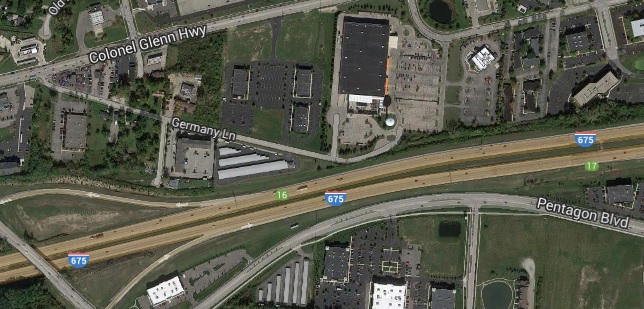 When crossing North Fairfield Road, New Germany-Trebein Road changes its name to Pentagon Boulevard, which formerly connected to Germany Lane in the town of New Germany across the highway. Looking at an aerial map, you can pretty clearly see where the roads previously met.
When crossing North Fairfield Road, New Germany-Trebein Road changes its name to Pentagon Boulevard, which formerly connected to Germany Lane in the town of New Germany across the highway. Looking at an aerial map, you can pretty clearly see where the roads previously met.
We have a GREAT FUTURE in Beavercreek, short term and on the horizon! Spirits are high, new businesses and restaurants are opening, homes are selling and our community is booming! We're looking forward to a number of exciting projects...
Community
- The McAfee Sports Center - Two generations of youth have learned the joy of athletics through Beavercreek Stars basketball at Henley Hall.
Latest Blog Posts
- Just Don't Call Us Late For Dinner...
- Remember When...
- What A Long, Strange Trip It's Been...
- Snow Down = Slow Down
- School Bus Safety - Just Do It!
- Stevenson Road Covered Bridge
- Our Road Crews Are Worth Their Salt!
- The Most Colorful Of Seasons!
- Popcorn Fest! - Then And Now
- Pre-School Paradise!
- Remembering Riffles
- Ten Year Anniversary Of The Beaver Statues


